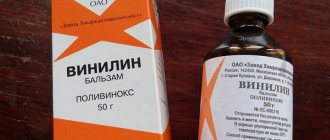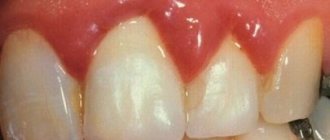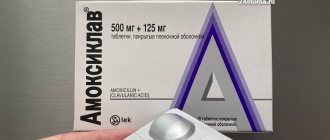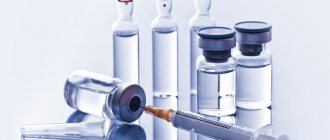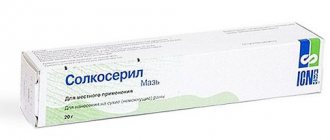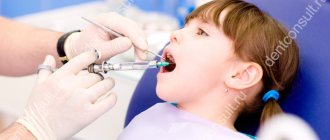Analogs
There is no exact analogue of the balm. The following drugs have the same properties:
- Hydrogen peroxide. A strong antiseptic, used to remove dirt and pus from wounds. Is an antioxidant. When treating wounds, foam is formed that closes the vessels and stops bleeding. Used to remove pathogenic microflora from mucous membranes.
- Elekasol. This is a herbal mixture consisting of licorice, chamomile, sage and other plants. Like Shostakovsky's balm, it has an antimicrobial effect and relieves inflammation and tissue swelling well. Used for the treatment of dental, urological, gynecological diseases.
- Iodoform. The powder is used externally only. Wound surfaces are treated; if necessary, the product is diluted for better penetration into closed areas.
- Naftaderm. The ointment is made from naphthalan oil. It is an antiseptic, has a resolving effect, and is used externally. Relieves inflammation, softens tissues.
Other analogues are Methylene blue, Potassium permanganate, Hexicon, Septifril, Pantocid.
The balm is sold without a prescription. The cost of the drug Vinilin is from 100 rubles per 50 ml.
Composition and release form
You can find “Polivinox” on sale, packaged in capsules, as well as bottled in containers (flask, bottle) made of dark-colored glass. Container capacity - 50, 100 g, 1 g of liquid contains 1 g of polyvinyl butyl ether. Another name for the active substance is polyvinox. There are no auxiliary components in the drug.
| Name | Tara | Material | Volume |
| Balm (“Polivinox”) | Bottle | Dark glass | 100 g |
| Balm (“Polivinox”) | Bottle | Dark glass | 50 g |
| "Vinilin" | Bottle | Dark glass | 100 ml |
| "Vinilin" | Bottle | Dark glass | 180 ml |
Upon contact, “Vinilin” has three types of therapeutic effects on mucous tissues:
- epithelializing;
- antimicrobial;
- anti-inflammatory.
The main component of the drug is polyvinox. The active substance is characterized by antimicrobial activity. The bacteriostatic effect of Vinilin first slows down and then completely interrupts the vital activity of pathogenic microflora.
When Vinilin is applied externally, the child’s pain in the throat decreases. The product coats the inflamed mucous membranes of the throat well, this promotes active regeneration processes that begin in the tissues, this leads to a reduction in inflammation.
Price of Vinilin (Shostakovsky balm), where to buy
The price of Vinilin in a 50 g bottle in Russia is 190-220 rubles. In different regions of Russia, prices are almost the same, although in Chelyabinsk this form of the drug can be purchased for 155 rubles.
Vinyl in a 50 g bottle, which resembles an ointment in consistency and is often used for stomatitis, wounds, burns and other lesions in Ukraine, can be bought for an average of 28-35 hryvnia.
- Online pharmacies in RussiaRussia
- Online pharmacies in UkraineUkraine
ZdravCity
- Vinyline liquid d/v.
and adv. approx. fl 100g No. 1AO Tatkhimfarmpreparaty 152 rub.order - Vinyl liquid for outside approx. 100gJSC Usolye-Sibirsky Chemical Pharmaceutical Plant
RUB 143 order
- Vinyl liquid for external application, approx. 50 g, JSC "Usolye-Sibirsky Chemical Pharmaceutical Plant"
87 RUR order
- Vinilin (Shostakovsky balm) 100g Tula Pharmaceutical Factory LLC
RUB 153 order
- Vinilin (Shostakovsky balm) 50g JSC KHIMREAKTIVKOMPLEKT FACTORY
115 rub. order
Pharmacy Dialogue
- Vinilin (flask 50g) Khimreaktivkomplekt plant
110 rub. order
- Vinilin (flask 100g) Usolye-Sibirsky Chemical Physics Complex
RUB 143 order
- Vinilin (flask 50g) Tula FF
97 RUR order
- Vinylin (bottle 100g) Ivanovskaya farm. f-ka.
RUB 161 order
- Vinylin (flask 50g) TCPP
86 rub. order
show more
Pharmacy24
- Vinyline 100 g (Shostakovsky balm) solution PAT "Vitamin" Ukraine
95 UAH.order - Vinyl balm Shostakovsky 50 g PAT "Vitamin" Ukraine
52 UAH order
Instructions for use
Rectal, external and internal use of Vinilin is indicated. Let's consider the basic rules for using the balm for various pathologies.
Externally
According to the instructions for use, Vinilin can be used in pure form or in 20% solutions obtained from substances in which the balm is dissolved. The product is applied to the wound or soaked in gauze pads and applied to the skin.
The surface can be covered for better absorption of the balm. The procedure is carried out 1-2 times a day, closing the wound for 1 hour.
For mastitis, fabric soaked in Vinylin is applied to the seals on the mammary gland and fixed.
For the mucous membranes of the mouth
For stomatitis or other lesions of the oral mucosa, soak a cotton swab on a stick in Vinilin and apply the product to the erosion. This method is used when minor areas of mucous membranes are affected.
Another way to use it for large areas of ulcers is to rinse with the prepared solution. You should treat your mouth 3-4 times a day. In this case, the composition can be swallowed. After application, a protective film is formed on the surface of the mucous membrane, protecting against irritation and accelerating healing.
For children, erosions with stomatitis are carefully lubricated, keeping them from drinking and eating for 1-2 hours
Gastrointestinal pathologies
To treat the mucous membranes of the digestive tract, it is necessary to wait for the maximum emptying of the stomach and ensure prolonged contact with the medicine. Therefore, Shostakovsky balm is taken 5 hours after meals (dinner) at night. On the first day of therapy, the volume of Vinilin is 1 teaspoon. Further:
- For gastritis with increased production of gastric juice, take a dessert spoon of balm every other day for 10-14 days.
- For ulcerative processes of the gastrointestinal tract - 1 dessert spoon per day for 2-3 weeks.
After using the balm, do not eat.
Rectally
External hemorrhoids or anal fissures are simply lubricated with balm or gauze napkins soaked in the product are applied. After applying Vinilin, you need to lie down for 20 minutes.
The drug is applied 3-4 times a day. The entire course lasts from a week to two.
For rectal insertion, a rectoscope or rubber bulb is used. Before administration, the intestines should be emptied. Vinyl should be slightly heated to a warm state, the volume should be at least 25 ml.
The balm helps well with non-advanced hemorrhoids. If the dynamics are positive, the course is completed, and after a week's break the treatment is repeated.
For frequent exacerbations, the balm is also used prophylactically in non-acute periods - once a day at night. The course is a week.
The same therapeutic actions are carried out for dysentery to reduce inflammation of the rectum.
Use in childhood
The instructions indicate that the drug should be used from 18 years of age. In practice, many pediatricians use Vinyl for children, and even use it in the treatment of infants up to one year old. In a reduced dosage, with caution, this drug gives a noticeable therapeutic effect. Self-medication is strictly forbidden. You can use Vinilin only after consulting a doctor.
Vinilin has proven itself well in the treatment of stomatitis in children. The balm covers the damaged areas of the gums, forms a protective film over it - this promotes pain relief and rapid healing. Treatment of mucosal surfaces can occur by rinsing.
https://youtu.be/7603TRXU_W0
For babies under one year old, the balm is applied to the pacifier. For older children, you can use gauze pads to precisely apply the medication to the sore spot. Treatment is carried out several times a day. Only after eating, after 1.5 hours, should you first rinse your mouth. After lubricating the gums, you should not eat or drink for 40 minutes.
Therapy can be carried out in combination with medications. No negative reactions from the interaction of Vinilin with other drugs have been registered. Relief from using the balm for stomatitis should occur within 7 days. If this does not happen, you should consult a doctor to adjust the treatment.
Vinilin is used for the throat in the treatment of sore throat. The instructions do not indicate this method; it can be considered as a recipe for traditional medicine. During the day, the sore throat should be lubricated several times with a cotton swab dipped in balm. The procedure does not replace the use of other medications. It only helps to alleviate the child’s condition and helps relieve symptoms.
If a small child has cracks in the anal area, hemorrhoids, the balm should be applied to a sterile napkin and applied to the sore spot for 30 minutes. Do the procedure 4 times a day. Continue treatment for 1 - 2 weeks depending on the severity of the disease.
Other indications for use
Vinilin is used for a variety of damage to the skin and mucous membranes:
- Pustular lesions;
- Carbuncles;
- Vein diseases;
- Burns;
- Dermatitis;
- Boils;
- Trophic ulcers;
- Mastitis (inflammation of the mammary glands in women);
- Frostbite of the skin;
- Cuts, cracks, minor damage to the skin.
The balm is suitable for oral administration undiluted and as a mixture with vegetable oil. Vinylin can be mixed with other dosage forms - ointments, pastes. The balm is used internally to treat ulcers and gastritis with high acidity.
Analogues and price of the drug
The drug "Vinilin" has practically no analogues. There are only synonymous drugs that also contain polyvinox as an active ingredient. Such medications include Shostakovsky balm, Polivinox and Polivinin-Rusfar. These drugs can be used as a replacement for the original medicine without prior consultation with a doctor, since they have the same indications, contraindications and side effects.
As for the price, for the drug “Vinilin” it can be different and depends on the volume of the bottle. On average, 50 ml of balm is sold for 200 Russian rubles, and 100 ml - for 290-300 rubles.
Description
Vinilin is used as an antiseptic for sore throats. The balm has a thick and viscous consistency. The medicine is light yellow in color and has a specific odor. The balm is sold in dark glass bottles.
The specificity of the drug is that it does not dissolve in water, but it does not dissolve in oil and alcohol. “Viniline” is also called “Shostakovsky’s Balm”. It acts as a medicine, reduces inflammatory processes, kills microbes, prevents them from actively spreading, cleans abrasions, ulcers, cuts, promotes their healing, and envelops the mucous membrane.
Vinilin has a bacteriostatic effect. The balm is sold in capsules and jars of 100 milliliters. "Vinilin" is a medicine that also has an anti-inflammatory effect. Promotes tissue regeneration, epithelization, stimulates wound healing, cleanses the skin of suppuration. After using it, the stitches heal faster and the scars become less noticeable.
Pharmacodynamics and pharmacokinetics
Pharmacodynamics
Polivinox improves tissue restoration and healing, providing an additional anti-inflammatory effect. It also demonstrates local antimicrobial and enveloping effects.
Pharmacokinetics
The antiseptic effect is caused by the ability of the drug to dehydrate microbial cells, coagulating protein and thereby provoking the death of microbes. As a consequence, restoration occurs by replacing the area of necrosis with connective or specific tissue.
When used externally, it promotes epithelization, wound cleansing, and tissue regeneration.
Instructions for use of Vinilin
Indications for use
- Carbuncles;
- boils;
- purulent wounds of soft tissues;
- trophic ulcers;
- burns;
- frostbite;
- dermatitis (inflammatory skin diseases);
- strepto-staphyloderma (pustular skin diseases);
- scabies;
- mastitis (purulent inflammation of the mammary gland);
- post-radiation lesions (for cancer);
- haemorrhoids;
- stomatitis (inflammation of the oral mucosa);
- gingivitis (inflammation of the gums);
- glossitis (inflammation of the mucous membrane of the tongue);
- periodontal disease (damage to periodontal tissue);
- irritation of the oral mucosa when using removable dentures;
- leukoplakia (damage to the mucous membrane of the cervix);
- dysentery;
- ulcerative colitis;
- anal fissures (fissures in the anus due to prolonged constipation);
- erosive gastritis;
- Crohn's disease;
- hyperacid gastritis (with high acidity);
- peptic ulcer of the stomach and duodenum;
- erosive gastritis.
Contraindications
Vinylin is not prescribed:
- during pregnancy and breastfeeding;
- in childhood (contraindicated for internal use);
- in case of individual intolerance to Vinilin or its components;
- for kidney diseases;
- for diseases of the liver and gall bladder.
Side effects
If you follow the dosages prescribed by your doctor, there are no side effects.
In case of an overdose of the drug, an allergic reaction may occur in the form of redness, itching or rashes in the form of hives.
Treatment with Vinilin
How to use Vinilin?
Vinylin can be used externally and internally.
For external use
Vinylin is applied to a napkin or directly to the surface of the wound in sufficient quantity.
For external use, Vinilin can be used both in pure form and in the form of a 20% solution in any vegetable oil (sea buckthorn oil, rosehip oil and others) and in the form of an ointment (compatible with other ointments, pastes, creams).
Inside
Vinyline can be taken as a balm (undiluted) 5-6 hours after a light dinner.
Vinyline can also be administered through a proctoscope.
(a special apparatus for examining the large intestine) or with a syringe through a rectal rubber tube (for microenemas).
It can be inserted into the rectum using a rubber bulb
.
In the form of a therapeutic enema, either pure Vinylin or diluted in half with fish oil is administered.
Dosage of Vinilin when taken orally .
1 teaspoon of balm is prescribed on the first day, all subsequent days - 1 dessert spoon 1 time per day; the course of treatment is 15-20 days (for peptic ulcers) or 10-12 days (for severe heartburn or gastritis with increased secretion).
Through a rectoscope
25-40 ml of Vinilin are administered; for microenemas – 15-30 ml; course of treatment up to 10 days; in therapeutic enemas, up to 100 ml (pure Vinilin or with fish oil) is administered 2 times a week for 3-4 weeks.
Medicines VINYLIN (for internal use)
Instructions| History of creation | What cures | Where can I buy |
The use of Vinilin in dentistry The use of mixtures with Shostakovsky balm in the treatment of certain pathological conditions of the soft tissues of the oral cavity Clinical studies were carried out at the Department of Surgical Dentistry of the I Leningrad Medical Institute. acad. I.P. Pavlova. The results of the study were published in the journal “Dentistry” No. 1, 1977. Vinilin (Shostakovsky’s balm) has pronounced anti-inflammatory and bacteriostatic properties, has a beneficial effect on reparative processes in the treatment of both fresh and trophic ulcers (B.M. Blyakhman, 1948; V.A. Avakova and Z.F. Shostakovsky, 1949; E.Y. Chass, 1950; V.A. Sondak and A.I. Ruderman, 1951; G.M. Vitalieva et al., 1967; L.N. Tikhonov and V.N. Tikhonova, 1970; I.G. Kuznetsov, 1971). Using Shostakovsky balm for 7 years, we were convinced of its healing effect in many pathological processes in the soft tissues of the oral cavity: gingivitis, stomatitis, glossitis, processes such as leukoplakia, etc. Shostakovsky's balm turned out to be very effective as a preventive and therapeutic agent during radiation therapy for oncological diseases of the maxillofacial area and already developed post-radiation lesions of the oral mucosa. We use balm mixtures containing anesthesin for glossalgia and for various manifestations in the oral cavity of intolerance or irritation of the plastic of removable dentures. The balm was applied topically while simultaneously eliminating the effects of local and general pathogenic factors. As our experience has shown, in order to prevent post-radiation lesions of the oral mucosa, it is advisable to use Shostakovsky balm in its pure form; for more pronounced phenomena, a mixture of balm with vitamin A. If in these cases a burning sensation, parasthesia or pain is noted, anesthesin is added to this mixture , and if there is bleeding gums, vitamin K is added to the mixture. In case of severe inflammatory phenomena, which often occur with periodontal disease, we add sulfonamide preparations to the mixture of balm, vitamin A and other ingredients. The dosage of each of these ingredients varies depending on the form and severity of the pathological process. Below are approximate recipes for the individual mixtures of Shostakovsky balm used.
| Mixture 1 Rp. Vinylinum 50.0 Vitamini A 6 -10.0 Oleosa Ol.Menthae Piperitae 1.0 | Mixture 4 Rp. Vinylinum 50.0 Vitamini A 6 -10.0 Oleosa Streptosidi albi 10.0 Ol.Menthae Piperitae 1.0 |
| Mixture 2 Rp. Vinylinum 50.0 Vitamini A 6 -10.0 Oleosa Anaesthesini 4-8.0 | Mixture 5 Rp. Vinylinum 50.0 Vitamini A 6 -10.0 Oleosa Vitamini K 0.5 Sulfodimetoxini 10-15.0 |
| Mixture 3 Rp. Vinylinum 50.0 Vitamini A 6 -10.0 Oleosa Vitamini K 0.5 Ol.Menthae Piperitae 2.0 | Mixture 6 Rp. Vinylinum 50.0 Vitamini A 6 -10.0 Oleosa Vitamini K 0.5 Anaesthesini 4-8.0 Sulfodimetoxini 10-15 Ol.Menthae Piperitae 2.0 |
In order to eliminate the unpleasant taste, especially for patients with hypersensitivity, peppermint infusion or oil is added to the balm mixture. Before use, the balm is heated in a water bath and the ingredients specified for the intended purpose are added, if necessary. The patient directly from the bottle takes 1-1.5 ml of the drug into his mouth and actively lubricates the entire mucous membrane with his tongue, while making movements for 5-8 minutes, as when rinsing the mouth. The balm is mixed with saliva, and then the patient swallows it. By the way, patients suffering from stomach disease usually note an improvement in their condition after using the indicated doses of balm. For limited lesions of the oral mucosa and the development of pathological foci in the area of the lower lip, lubrication or application with the indicated balm mixtures is used. For periodontal disease with severe inflammatory changes and bleeding, gum massage is indicated. Without heating, mix the balm thoroughly, then take a piece of lemon peel or foam sponge measuring 4x5 cm and apply a layer of one of the indicated mixtures (usually No. 5 or No. 6) to its inner surface and massage with the index finger of the right hand for 5-8 minutes gums on both sides. The balm or its mixture is used 1-2 times a day, 2 hours before meals or after meals and at night. According to the described method, Shostakovsky balm in its pure form was used in 36 patients to prevent complications of radiation therapy. Only 4 patients had a minor post-radiation reaction; in the remaining patients, the development of any complications from the oral mucosa was completely prevented. Shostakovsky's balm and, in particular, its mixture No. 2 are very effective for such sensitivity disorders as glossalgia and various manifestations of paresthesia (burning sensation, etc.) that have developed from various causes. In 42 patients with the specified suffering, the use of a mixture of balm No. 2 was successful. Already by the 5-6th day of treatment, patients noted an improvement, and after a 15-20-day course of treatment, in most patients the complaints completely disappeared. And only in some patients complete success was achieved after a second course of therapy, which was administered 8-10 days after the first. Finally, in 62 patients with various inflammatory manifestations of periodontal disease, mixtures No. 4, 5 and 6 were used. The choice of one or another mixture depended not only on the nature and intensity of the inflammatory reaction, but also on the degree of sensitivity disorders and bleeding gums. In these patients, good results can be achieved through a 12-20-day course of treatment. The inflammatory reaction noticeably decreased, hypersensitivity symptoms partially or completely disappeared, and gum bleeding stopped. If an exacerbation of the process occurred, repeated courses of treatment were carried out after a 10-12-day break. Experience has shown that even long-term use with appropriate short breaks of mixtures of Shostakovsky balm, including those containing sulfonamide drugs, does not cause any local or general complications. In only 8 patients, the researchers were forced to refuse treatment with the balm due to intolerance to its smell and taste. Thus, the absence of any harmful effects even with long-term use of the balm and medicinal substances included in mixtures based on it, with such a high therapeutic effectiveness, makes it possible to widely recommend the use of Shostakovsky balm and mixtures based on it in the practice of a dental clinic. Complex treatment of periodontal disease using biomycin paste on Shostakovsky balm The study was carried out in the Sochi sanatorium of the USSR Ministry of Defense (Sochi). The results of the study were published in the journal “Dentistry” No. 1 for 1967. This work evaluates the complex treatment of periodontal disease using biomycin paste based on Shostakovsky balsam. Under observation were 120 patients with periodontal disease (88 men and 32 women). There were 4 patients under the age of 30 years, 34 patients from 31 to 40 years old, 33 patients from 41 to 50 years old. Of the observed patients with periodontal disease: 62 - functional disorders of the nervous system; 47 — cardiovascular diseases; 4 - metabolic diseases; 3 - diabetes mellitus; 2 — disease of the gastrointestinal tract; 2 - there are no diseases of internal organs. The sclerotic form of periodontal disease was observed in 47 patients, mixed - in 60 and abscessive - in 13. Of these, 12 people had degree I damage, 85 - II, and 23 - III. Local treatment consisted of removing supragingival and subgingival tartar, curettage of pathological gingival pockets, followed by treating them with biomycin paste (50,000 units of biomycin were mixed in 1 ml of Shostakovsky balm). The paste was prepared before use and used daily or every other day. In addition, the oral cavity was irrigated with Matsesta water for 5-10 minutes. (hydrogen sulfide concentration 150 ml, temperature 37-38? C), gum electrophoresis was performed with a 5% ascorbic acid solution, 10% calcium chloride solution, aloe therapy, abscesses were opened. The immediate results of complex treatment of periodontal disease using biomycin paste on Shostakovsky balsam showed that 88 patients experienced significant improvement in the first days. Analyzing the results of complex treatment of periodontal disease, the following conclusion was made: in patients with sclerotic forms of periodontal disease I-III degrees, good results are achieved by irrigating the oral cavity with Matsesta water in combination with physiotherapeutic procedures and treating pathological gum pockets with biomycin paste. For mixed and abscessive forms of periodontal disease II-III, in addition to oral irrigation and physiotherapeutic treatment, it is advisable to carry out aloe injections, and it is also necessary to treat pathological gum pockets with biomycin paste. It very quickly eliminates inflammation, reduces pain and stops discharge from pathological gum pockets. The paste has not only antimicrobial and anti-inflammatory, but also an anesthetic effect, promoting a sustainable cure for hyperesthesia of exposed tooth necks.
Vinylin
Vinylin instructions
Vinilin is a domestic antiseptic. It has anti-inflammatory, antibacterial, enveloping and regenerating effects. Promotes disinfection of wounds, restoration of tissue integrity, formation of epithelium in places of damage to the skin. Experiments on the synthesis of vinyl esters began back in 1888. Vinilin himself was created by M.F. Shostakovsky in 1941, during the war, when the country experienced an urgent need for anti-inflammatory, antipyretic and anti-burn drugs. The drug, which is also called Shostakovsky’s Balm, is still in use today. It is used for local purulent inflammation of the skin, trophic ulcers, inflammation of the mammary gland, soft tissue damage, temperature damage to the skin (burns, frostbite). Vinilin is used orally for ulcerative-erosive lesions of the stomach and duodenum, inflammation of the mucous membrane of the stomach and large intestine. The drug occupies a special place in solving the problem of burn injuries. A burn wound has a very specific healing process, which determines the tactics of their treatment: local therapy, measures to quickly close the surface of the wound to prevent bacterial contamination and intoxication, activation of epithelium formation on the wound surface
The following requirements are put forward for drugs used to treat burn wounds: bactericidal properties, absence of negative effects on cells and tissues, stability of action upon contact with living tissues, non-volatility, convenience and ease of use (important when providing emergency care). In recent years, many new drugs have appeared for the treatment of burn wounds, however, the high number of allergic reactions and the emergence of antibiotic-resistant strains force one to turn to proven drugs, the clinical effectiveness of which has long been known and is beyond doubt.
One such medicine is Vinilin. It ensures wound healing without complications. In terms of bactericidal activity, Vinilin is somewhat inferior to Levomekol, but is superior to this drug in the speed of wound healing. In addition, dressings with Vinilin can be changed less often than with Levomekol. Vinilin provides brighter and more even granulations and less painful dressing changes. When using Vinilin, wound healing occurs, as a rule, without peripheral inflammation. Due to the elasticity of the bandage, pain is usually less severe than with other medications. A characteristic feature of the drug is a slight burning sensation under the bandage, which lasts about 15-20 minutes after the first application. Vinilin has a specific odor, to which patients quickly get used to, and the deodorizing effect of the drug subsequently becomes even pleasant. Vinylin can be applied to the skin using sterile medical wipes, or directly to the skin directly from the bottle. It is planned to release Vinilin in the form of an aerosol, which will minimize losses when directly applying the drug to the skin and eliminate the inconvenience of its distribution over the skin. The frequency of use of the drug is 3-5 times a day. Undesirable side effects are allergic reactions in the form of skin rashes. Contraindications for use are individual intolerance to the components of the drug, as well as pregnancy and lactation (for oral administration only).
Contraindications for the drug Vinilin
- Children's age up to 14 years.
- Kidney and liver diseases.
- Individual intolerance to some components of the drug.
But very often dentists prescribe a balm for stomatitis for children who have not yet turned 14 years old. It is important that the child is not able to swallow the medicine. In addition, you need to carefully monitor the baby's condition: if you see the slightest rash, stop using the drug and show the child to the doctor.
Keep in mind that Vinilin can only eliminate the unpleasant manifestations of stomatitis; the causes of the development of the disease are hidden deeper. It is for this reason that you cannot treat with balm yourself. It is better to seek help from a dentist and pediatrician.
Features of use
Despite contraindications for the use of ointment before the age of 14, dentists often prescribe it for the treatment of stomatitis in children. You just need to follow the dosage and all the doctor’s recommendations.
The ointment should be used with extreme caution in children who are prone to allergies. In case of the slightest manifestation of an allergic reaction, you must stop using the drug, even if it copes well with the symptoms of the disease.
Often ointment is prescribed for the treatment of candidal stomatitis in infants. In this case, it is imperative to monitor the condition of the baby and follow the dosage.
Indications
Vinylin is used:
- If the skin or soft tissue becomes infected, for example with a boil or abscess.
- For trophic skin ulcers.
- For dermatitis.
- For various injuries (for example, abrasions and bruises).
- For open wounds on the skin.
- From diaper rash.
- For chemical or thermal burns.
- For post-traumatic infection.
- For anal fissure and hemorrhoids.
- For chickenpox (to treat blisters in the mouth).
- With frostbite.
- For sore throat, granulosa pharyngitis and other infections of the throat and tonsils.
- For stomatitis, gingivitis, glossitis and other lesions of the oral mucosa.
The medicine is taken orally for high acidity and heartburn (erosive or hyperacid gastritis), peptic ulcer or ulcerative colitis. Comprehensive treatment of such diseases is necessary. The solution injected using a rectoscope is used for colitis and dysentery.
Contraindications and side effects
The manufacturer does not guarantee the complete absence of side effects from the use of Vinilin. The reasons for their appearance in most cases are associated with incorrect dosage of the medicine. The annotation for the medicine states that it is not recommended for children. However, medical practitioners note the positive effect of the balm on babies. In case of an overdose, a child may develop consequences in the form of allergic skin rashes:
- the skin turns red;
- itches;
- rashes appear.
Such side effects are typical for children who are intolerant to the medicinal components included in the drug. Allergies are manifested by dermatological changes. In addition to itching and redness, the child may experience swelling.
No other adverse reactions were detected with the balm. The active substance does not penetrate tissue cells and does not have a toxic effect on the body. There is a list of pathologies for which Vinilin is not recommended:
- kidney disease;
- liver pathologies;
- gallbladder diseases.
Release forms
| Dosage | Packing | Storage | Sale | Best before date |
50; 100
Short description
Vinilin is a domestic antiseptic. It has anti-inflammatory, antibacterial, enveloping and regenerating effects. Promotes disinfection of wounds, restoration of tissue integrity, formation of epithelium in places of damage to the skin. Experiments on the synthesis of vinyl esters began back in 1888. Vinilin himself was created by M.F. Shostakovsky in 1941, during the war, when the country experienced an urgent need for anti-inflammatory, antipyretic and anti-burn drugs. The drug, which is also called Shostakovsky’s Balm, is still in use today. It is used for local purulent inflammation of the skin, trophic ulcers, inflammation of the mammary gland, soft tissue damage, temperature damage to the skin (burns, frostbite). Vinilin is used orally for ulcerative-erosive lesions of the stomach and duodenum, inflammation of the mucous membrane of the stomach and large intestine. The drug occupies a special place in solving the problem of burn injuries. A burn wound has a very specific healing process, which determines the tactics of their treatment: local therapy, measures to quickly close the surface of the wound to prevent bacterial contamination and intoxication, activation of epithelium formation on the wound surface
The following requirements are put forward for drugs used to treat burn wounds: bactericidal properties, absence of negative effects on cells and tissues, stability of action upon contact with living tissues, non-volatility, convenience and ease of use (important when providing emergency care). In recent years, many new drugs have appeared for the treatment of burn wounds, however, the high number of allergic reactions and the emergence of antibiotic-resistant strains force one to turn to proven drugs, the clinical effectiveness of which has long been known and is beyond doubt.
One such medicine is Vinilin. It ensures wound healing without complications. In terms of bactericidal activity, Vinilin is somewhat inferior to Levomekol, but is superior to this drug in the speed of wound healing. In addition, dressings with Vinilin can be changed less often than with Levomekol. Vinilin provides brighter and more even granulations and less painful dressing changes. When using Vinilin, wound healing occurs, as a rule, without peripheral inflammation. Due to the elasticity of the bandage, pain is usually less severe than with other medications. A characteristic feature of the drug is a slight burning sensation under the bandage, which lasts about 15-20 minutes after the first application. Vinilin has a specific odor, to which patients quickly get used to, and the deodorizing effect of the drug subsequently becomes even pleasant. Vinylin can be applied to the skin using sterile medical wipes, or directly to the skin directly from the bottle. It is planned to release Vinilin in the form of an aerosol, which will minimize losses when directly applying the drug to the skin and eliminate the inconvenience of its distribution over the skin. The frequency of use of the drug is 3-5 times a day. Undesirable side effects are allergic reactions in the form of skin rashes. Contraindications for use are individual intolerance to the components of the drug, as well as pregnancy and lactation (for oral administration only).
Pharmacology
A product that improves tissue regeneration with an anti-inflammatory effect. It also has an antimicrobial, local anti-inflammatory and enveloping effect.
When used externally, it promotes wound cleansing, epithelization, and tissue regeneration.
Release form
| Balm | 1 fl. |
| polyvinox | 100 % |
50 g - bottles (1) - cardboard packs. 100 g - bottles (1) - cardboard packs. 50 g - bottles (50) - cardboard boxes. 100 g - bottles (50) - cardboard boxes.
Dosage
Apply externally by wetting wipes or applying directly to the wound surface.
When taken orally, a single dose is 1.4 g, frequency of administration is 3-5 times a day.
Indications
For external use: boils, carbuncles, trophic ulcers, purulent wounds, mastitis, soft tissue injuries, burns, frostbite, inflammatory skin diseases.
For oral administration: peptic ulcer of the stomach and duodenum, gastritis, colitis.
Instructions for use of Vinilin
Side effects
If you follow the dosages prescribed by your doctor, there are no side effects.
In case of an overdose of the drug, an allergic reaction may occur in the form of redness, itching or rashes in the form of hives.
Treatment with Vinilin
How to use Vinilin?
Vinylin can be used externally and internally.
For external use
Vinylin is applied to a napkin or directly to the surface of the wound in sufficient quantity.
For external use, Vinilin can be used both in pure form and in the form of a 20% solution in any vegetable oil (sea buckthorn oil, rosehip oil and others) and in the form of an ointment (compatible with other ointments, pastes, creams).
Inside
Vinyline can be taken as a balm (undiluted) 5-6 hours after a light dinner.
Vinyline can also be administered through a proctoscope.
(a special apparatus for examining the large intestine) or with a syringe through a rectal rubber tube (for microenemas).
It can be inserted into the rectum using a rubber bulb
.
In the form of a therapeutic enema, either pure Vinylin or diluted in half with fish oil is administered.
Dosage of Vinilin when taken
orally
: 1 teaspoon of balm is prescribed orally on the first day, all subsequent days - 1 dessert spoon 1 time per day; the course of treatment is 15-20 days (for peptic ulcers) or 10-12 days (for severe heartburn or gastritis with increased secretion).
Through a rectoscope
25-40 ml of Vinilin are administered; for microenemas – 15-30 ml; course of treatment up to 10 days; in therapeutic enemas, up to 100 ml (pure Vinilin or with fish oil) is administered 2 times a week for 3-4 weeks.
Vinilin (Shostakovsky balm) 50ml
Dosage form:
balm
Compound
Polivinox (vinyline) – 50 g or 100 g
Description:
thick, viscous liquid of light yellow color, specific odor. Doesn't thicken or dry out in air.
Pharmacotherapeutic group:
antiseptic
ATX code:
[D08AX]
pharmachologic effect
It has an antimicrobial effect, promotes wound cleansing, tissue regeneration and epithelization. When taken orally, it acts as an enveloping, anti-inflammatory and bacteriostatic agent.
Indications for use
Externally: boils, carbuncles, trophic ulcers, purulent wounds, mastitis, soft tissue wounds, burns and frostbite.
Orally: in the complex treatment of erosive and ulcerative diseases of the stomach and duodenum, exacerbation of chronic gastritis with increased secretory function of the stomach.
Contraindications
Hypersensitivity.
When taking the drug orally: diseases of the liver, gall bladder and kidneys, pregnancy, breastfeeding, children under 18 years of age.
Directions for use and doses
Externally: for wetting wipes and direct application to the wound surface in sufficient quantities.
Orally: 1 time per day 5-6 hours after the last meal (a light dinner is recommended at 18:00 and taking the drug at 23-24:00).
For gastric and duodenal ulcers: 1 teaspoon on the first day, on subsequent days - 1 dessert spoon, course - 16-20 days.
For gastritis with increased secretory function: 1 teaspoon on the first day, then 1 dessert spoon every other day, course – 10-12 days.
Side effect
Allergic reactions.
Overdose
There are no data on cases of overdose.
Interaction with other drugs
Not studied.
Release form
Balm.
50 g, 100 g of the drug in orange glass bottles with a screw neck, sealed with polymer stoppers and polymer screw caps.
50 g, 100 g in polyethylene terephthalate bottles, sealed with polymer screw caps.
Each bottle, along with instructions for use, is placed in a cardboard pack.
It is allowed to place bottles in group packaging with an equal number of instructions for use.
Best before date
5 years. Do not use after the expiration date stated on the packaging.
Storage conditions
In a well-closed container, in a dry place, protected from light, at a temperature not exceeding 25 ° C.
Keep out of the reach of children.
Conditions for dispensing from pharmacies
Over the counter.
Best before date
The product is sold in pharmacies without a prescription. In accordance with the recommendations in the instructions, it must be stored at room temperature, with the lid tightly closed. This is the only way the shelf life of the medicine Vinilin reaches 5 years.
Vinilin is an indispensable antiseptic for the throat in the treatment of sore throat. It not only kills dangerous bacteria, but restores the mucous membrane, heals wounds and abrasions. We should not forget that the drug is not an independent medicine and is used only as an adjunct for the treatment of sore throat.
You need to keep Vinilin at home at a temperature below 25 degrees Celsius. The drug should be stored in a place hidden from children, and its bottle should always be tightly closed. The shelf life of the medicine is 5 years.
Vinilin has an antiseptic effect, helps cleanse wounds, delays the development and growth of pathogenic microbes, reduces pain, and has a wound-healing effect (promotes tissue regeneration and promotes the formation of a soft scar at the wound site).
ATX code: D03A X50. Antiseptic drugs.
Store in tightly sealed containers; capsules are stored in a dry place at a temperature not exceeding 30° C. Available without a prescription.
The shelf life of Vinilin is 5 years.
Store at room temperature. Keep away from children.
Five years.
Effect of the balm
“Vinilin” for stomatitis is most effective in treating its infectious and traumatic forms. The drug helps to disinfect the mucous membranes of the mouth, preventing the entry of new harmful microorganisms into infected areas. In addition, Shostakovsky balm promotes epithelial regeneration and restoration of the oral mucosa, which significantly speeds up the healing process.
Balm in the treatment of stomatitis effectively helps relieve pain. Due to the fact that the balm is able to envelop the mucous membrane, it protects it from further damage. A similar effect appears on the gastric walls during gastritis and ulcers, which significantly reduces the risk of developing allergic stomatitis.
“Vinilin” for stomatitis in adults of infectious or traumatic origin is not used as an independent drug, but is part of complex therapy. It is recommended to combine it with rinsing the mouth with herbal infusions; this approach speeds up the healing process and improves the patient’s well-being. In addition to the fact that the balm cleanses and disinfects ulcers well, it also creates a film on the oral mucosa, protecting it from bacteria and relieving pain.
According to the instructions for Vinilin, for stomatitis its effect can be increased through the use of other medications, but the decision on the prescription must be made by the attending physician. For mild cases of the disease, Shostakovsky's balm can relieve stomatitis in combination with herbal rinses. In more severe forms, the drug requires supplementation with other drugs, in particular antibiotics.
Another important point is that stomatitis can be a symptom of another, more serious disease. Oral ulcers may indicate pathology of hormonal, immune and oncological diseases.
The main symptoms of Vincent's stomatitis
The most common symptom is the presence of numerous ulcerations in the oral cavity: on the inside of the cheeks, lips, palate and other areas. Other manifestations may vary, depending on the degree of the disease.
Symptoms of mild ulcerative stomatitis:
- increased salivation;
- pain in the mouth, especially when palpating soft tissues;
- bleeding gums, especially when eating and brushing teeth;
- swelling of the gums.
Manifestations of ulcerative necrotic stomatitis of the middle stage.
- wounds with necrotic crusts;
- bleeding gums;
- unpleasant odor;
- pus secreted from periodontal pockets;
- enlarged and painful lymph nodes;
- muscle weakness and loss of strength;
- temperature increase;
- loss of appetite.
Symptoms of ulcerative stomatitis of complex stage.
- severe weakness;
- stomach ache;
- nausea;
- vomit;
- increased body temperature;
- deep ulcers that can reach the bone tissue.
If these symptoms appear, you must immediately consult a dentist! The disease is treated exclusively under the supervision of an experienced doctor - treatment at home can significantly aggravate the situation.
Instructions for use of vinylin
Short description
Vinilin is a domestic antiseptic. It has anti-inflammatory, antibacterial, enveloping and regenerating effects. Promotes disinfection of wounds, restoration of tissue integrity, formation of epithelium in places of damage to the skin. Experiments on the synthesis of vinyl esters began back in 1888. Vinilin himself was created by M.F. Shostakovsky in 1941, during the war, when the country experienced an urgent need for anti-inflammatory, antipyretic and anti-burn drugs. The drug, which is also called Shostakovsky’s Balm, is still in use today. It is used for local purulent inflammation of the skin, trophic ulcers, inflammation of the mammary gland, soft tissue damage, temperature damage to the skin (burns, frostbite). Vinilin is used orally for ulcerative-erosive lesions of the stomach and duodenum, inflammation of the mucous membrane of the stomach and large intestine. The drug occupies a special place in solving the problem of burn injuries. A burn wound has a very specific healing process, which determines the tactics of their treatment: local therapy, measures to quickly close the surface of the wound to prevent bacterial contamination and intoxication, activation of epithelium formation on the wound surface
The following requirements are put forward for drugs used to treat burn wounds: bactericidal properties, absence of negative effects on cells and tissues, stability of action upon contact with living tissues, non-volatility, convenience and ease of use (important when providing emergency care). In recent years, many new drugs have appeared for the treatment of burn wounds, however, the high number of allergic reactions and the emergence of antibiotic-resistant strains force one to turn to proven drugs, the clinical effectiveness of which has long been known and is beyond doubt.
One such medicine is Vinilin. It ensures wound healing without complications. In terms of bactericidal activity, Vinilin is somewhat inferior to Levomekol, but is superior to this drug in the speed of wound healing. In addition, dressings with Vinilin can be changed less often than with Levomekol. Vinilin provides brighter and more even granulations and less painful dressing changes. When using Vinilin, wound healing occurs, as a rule, without peripheral inflammation. Due to the elasticity of the bandage, pain is usually less severe than with other medications. A characteristic feature of the drug is a slight burning sensation under the bandage, which lasts about 15-20 minutes after the first application. Vinilin has a specific odor, to which patients quickly get used to, and the deodorizing effect of the drug subsequently becomes even pleasant. Vinylin can be applied to the skin using sterile medical wipes, or directly to the skin directly from the bottle. It is planned to release Vinilin in the form of an aerosol, which will minimize losses when directly applying the drug to the skin and eliminate the inconvenience of its distribution over the skin. The frequency of use of the drug is 3-5 times a day. Undesirable side effects are allergic reactions in the form of skin rashes. Contraindications for use are individual intolerance to the components of the drug, as well as pregnancy and lactation (for oral administration only).
Pharmacology
A product that improves tissue regeneration with an anti-inflammatory effect. It also has an antimicrobial, local anti-inflammatory and enveloping effect.
When used externally, it promotes wound cleansing, epithelization, and tissue regeneration.
Instructions for use of Vinilin (Shostakovsky balm) (Method and dosage)
The drug is allowed to be used externally, orally and rectally.
Vinylin, instructions for use
Externally: ointment (with the drug in the composition), balm in pure form or in the form of oil solutions is applied to napkins and with their help the affected area is directly treated.
Orally Vinilin (Shostakovsky balm) is taken once a day 5 hours after an evening meal (a small dinner at 6 pm and medication at 11 pm are recommended):
- for peptic ulcers, take 1 teaspoon of liquid on the first day, in the subsequent days of treatment take 1 dessert spoon per day (the course of treatment averages 17–20 days);
- for gastritis with increased secretion and heartburn, it is recommended to take 1 teaspoon of liquid on the 1st day, and then 1 dessert spoon every other day for 10–12 days.
into the rectum (via a rectoscope ) at a time for 3–9 days.
Vinylin for stomatitis is used to treat ulcers, for which the balm is applied to a cotton swab and the affected area is treated with it up to three times a day. Within 30 minutes after such a procedure, it is forbidden to drink or eat.
Vinilin for sore throat
It is allowed to use the drug for sore throat , treating the throat with a Vinyl-soaked cloth up to 4 times a day. However, it is worth noting that the effectiveness of the described treatment has not been proven.
pharmachologic effect
What is the drug "Vinilin"? Instructions and reviews from doctors indicate that this is a medicinal product that has an antimicrobial, enveloping and anti-inflammatory effect. When used externally, the medication helps cleanse and heal ulcers and wounds.
The antimicrobial effect of the drug manifests itself in inhibiting the development and growth of bacteria. The healing effect of the drug is associated with regenerative and enveloping properties.
When using the balm, scars remaining after healing of wounds and ulcers remain soft and almost invisible. It should also be noted that the drug in question acts as a local anesthetic.
How does Vinilin balm work when taken orally? Reviews from experts say that this drug has enveloping, anti-inflammatory and bacteriostatic properties. In this regard, it is very often used to treat gastrointestinal diseases.
This medication has a specific pungent odor. It is insoluble in water, but mixes quite well with ethyl ether, liquid paraffin, oils, chloroform, butyl and isoamyl alcohols.
It should also be noted that the balm does not thicken in air and does not dry out.
Composition and pharmacological action
The active ingredient of the drug is polyvinox. It determines the effect of the medication. The balm is intended for external and internal use. When used externally, it has the following effects:
- Destroys pathogenic microbes;
- Promotes local anesthesia;
- Disinfects the wound surface;
- Dries the damaged area;
- Promotes tissue restoration;
- Stimulates the growth of new cells.
When the balm is taken orally, it envelops the damaged area, which helps relieve pain and stimulate the restoration of the mucous membrane. The recovery and healing processes are accelerated.

